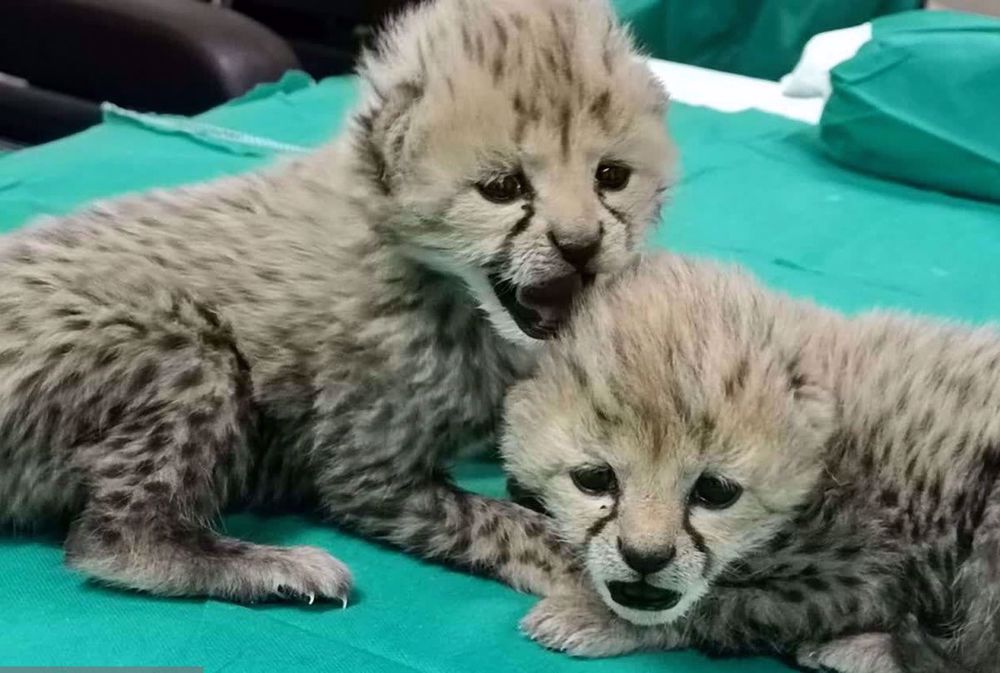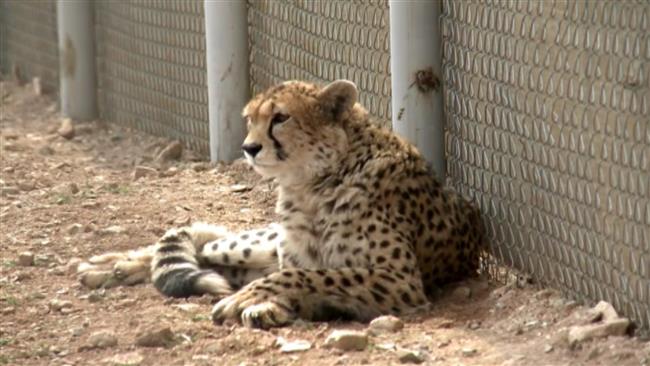Cheetah cubs found in Iran’s Touran good omen for endangered species' survival
By Maryam Qarehgozlou
The two Asiatic cheetah cubs found recently in Khar Touran National Park in central Iran's Semnan province represent a good omen for the survival of this endangered cheetah subspecies in Iran.
On Saturday, the story of the two cubs found by a livestock breeder went viral, rekindling hopes for the future of the animal known for its buff-to-light fawn-colored fur, which once roamed across Central Asia from the Middle East to Russia.
The fastest land animal in the world capable of reaching speeds of 120 kilometers (74 miles) per hour, listed by the International Union for Conservation of Nature (IUCN) as critically endangered, is now only spotted in some habitats in Iran, mainly in provinces of Semnan, Yazd, Kerman and Fars.
According to Iran’s Department of Environment (DOE), the discovery of the two cubs in Touran was “surprising” and “promising” at the same time and could mean that the shrinking population of this cheetah subspecies is likely to see a turnaround in Touran and other natural habitats across Iran.
Will the cubs survive?
It is still unclear if the two female cheetah cubs, both less than a month old, can survive without their mother. IUCN says cubs will stay with their mother until they are 18 months old.
In addition to breastfeeding the cubs, the mother will lick their bottoms to stimulate them to defecate and urinate. Parting from the mother could lead to some health conditions or even death.
Moreover, Cheetah Conservation Fund says chronic kidney disease is commonly seen in captive cheetahs. It is still not scientifically known why captive cheetahs are more prone to this condition than their wild counterparts, but diet, age, genetic diversity, and chronic stress are cited as risk factors.
The cubs might be transferred to the capital Tehran for further tests, according to some reports.
How the cubs ended up in captivity?
There is intense speculation over how the cheetah cubs parted from their mother, with some attributing it to wildlife trafficking.
However, as the female cheetah goes on daily expeditions looking for prey, the cubs, being very young cannot follow their mother, and that is how they were found by the livestock breeder who took them away to keep them safe from other large predators, including guard dogs.
According to Cheetah Conservation Fund, during the first few months, when cubs cannot follow their mother far or fast, the mortality rate is highest.
Return to Wildlife
The two cubs are still very young and cannot survive in the wild on their own and because their mother has not been sighted since they were found, it is most likely impossible to take them back to their natural habitat, hence their chance of mating and reproducing in the nature are pretty much thin.
The DOE is hopeful that the cubs could breed in captivity when they become sexually mature.
Nonetheless, cheetahs cannot easily breed in captivity, so it is not possible to predict whether the two cubs can reproduce anytime in the future.
Previous experiences
Two female Asiatic cheetahs, Delbar and Iran, and a male one, Kushki, have lived in captivity in the Pardisan Park, northwest of Tehran, for the past few years.
In 2015, Delbar got pregnant naturally but sadly lost her cub.
Later, while she was physically prepared for mating with Kushki, possibly due to the latter's old age, the two could not breed.
In 2021, Delbar underwent artificial insemination which proved unsuccessful.
In April 2020, DOE decided to transfer Delbar and Kushki to Semnan province where they ought to spend the rest of their lives in semi-captive conditions because “they are no longer able to reproduce.”
Iran, who was younger than the other two, with higher chances of pregnancy, was also transferred to a fenced area in the central part of the country.
In May this year, Iran gave birth to three cubs in captivity at the Touran Wildlife Refuge, the first in captivity for the endangered subspecies.
Two of the cubs could not survive, but the third one, a male cheetah named “Pirouz”, which translates to “victorious” in Persian, survived and is now kept in Pardisan Park.
Threats facing them
Cheetahs serve a special role in their ecosystem. They keep prey species healthy by killing the weak and old individuals, according to Cheetah Conservation Fund.
They also act as a population check that helps plants-life by preventing overgrazing. Without predators like the cheetah, the current ecological trend toward desertification would be accelerated, the Fund says.
However, the remaining small population of cheetahs in Iran is threatened by a number of natural and human-driven factors.
Wildlife-vehicle collisions on roads fragmented their habitats are one of the main threats to the species.
Abbasabad-Mayami road, linking Semnan to Mashhad in the northeastern province of Khorasan Razavi is considered one of the deadliest roads for Asiatic cheetahs.
Human-wildlife conflicts and the negative interactions between humans and wild animals can also lead to undesirable consequences for the cheetahs.
Free-ranging domestic dogs also threaten cheetahs as well as other predators through predation, competition for resources, and contributing to the transmission of diseases.
Drought spells, which decrease the population of prey species, leading to habitat loss, also threaten the cheetah’s already shrinking population.
In January, Hassan Akbari, a deputy environment head, said that the Asiatic Cheetah population was down to just 12, from an estimated 100 in 2010.
However, due to poor surveillance, it is not easy to determine the exact population of the cheetahs and the two young cubs found in Touran may indicate that the species are breeding in the wildlife more than already predicted, but are not sighted.
Fake deaths and celebs: Inside the farcical info war against Iran amid foreign-backed riots
Two MKO terrorists captured for roles in foreign-backed riots in Tehran
Trump source of ‘provocative, absurd’ messages on recent Iran riots: Envoy
‘French army fits in one football stadium’: Politician mocks troop deployment to Ukraine
At least 40 Palestinian journalists being held in Israeli prisons: Advocacy group
US delivers more F-35 jets to Israeli regime despite Gaza truce violations
Blair distances himself from Trump’s $1bn ‘Board of Peace’ fee
US Justice Department refuses probe into killing of Minneapolis mother















 This makes it easy to access the Press TV website
This makes it easy to access the Press TV website